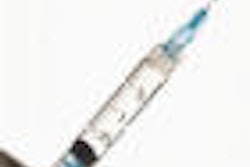The use of prilocaine in pediatric patients can increase the levels of methemoglobin in those patients, putting them at risk of associated problems that can include headache, dizziness, and seizures (Anesthesia Progress, Fall 2013, Vol. 60:3, pp. 99-108).
While the role of local anesthetics has made many dental procedures commonplace, the use of these drugs do come with risks, noted the study authors, from Loma Linda University School of Dentistry. Methemoglobinemia, a condition that affects oxygen levels in the blood, can result from injections of some local anesthetics. High levels can pose a risk to children in particular.
Methemoglobin is a form of hemoglobin in which ferrous (iron) ions oxidize to become ferric ions, ultimately causing less oxygen to be transported and released to the body's peripheral tissues, the researchers explained. While methemoglobin normally makes up 1% to 2% of a person's hemoglobin, higher percentages can cause problems. As methemoglobin levels progressively increase, symptoms can range from skin discoloration to headache, fatigue, dizziness, seizures, and coma.
For this study, the researchers measured methemoglobin levels following the use of two injectable local anesthetics. Study subjects were 90 children ages 3 to 6 years old who were undergoing dental rehabilitation under general anesthesia. They were randomly assigned to one of three groups: one using 4% prilocaine plain, one using 2% lidocaine with 1:100,000 epinephrine, and one with no local anesthetic.
The researchers compared maximum methemoglobin levels reached and the length of time it took to reach these peaks, and they found that the group treated with prilocaine showed significantly higher maximum methemoglobin levels. Those treated with the lidocaine and epinephrine combination did not experience methemoglobin levels any greater than the group given no local anesthetic. There was a notable difference in the time taken to reach peak levels. The group that did not receive a local anesthetic displayed peak levels in about a half hour, while the other groups were about an hour into the procedure before peak levels occurred.
While most dental clinicians are aware that methemoglobin can be induced by specific dental local anesthetics, they may not be as knowledgeable of the levels and toxic manifestations that can occur, the study authors concluded. Dental clinicians treating pediatric patients should be particularly vigilant of dosing guidelines that can help ensure the patient's safety, they emphasized.



















